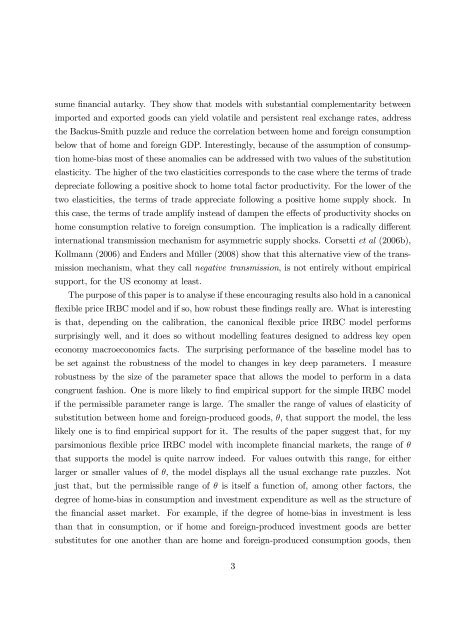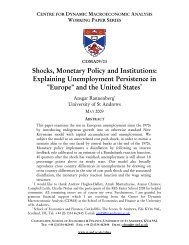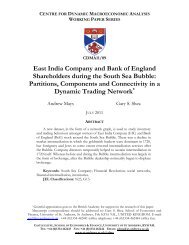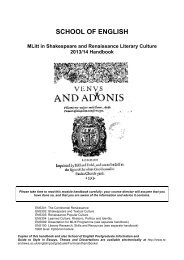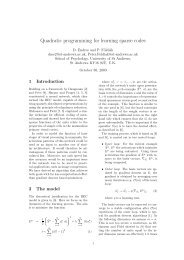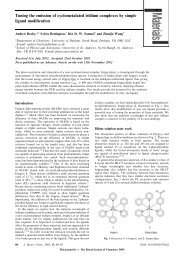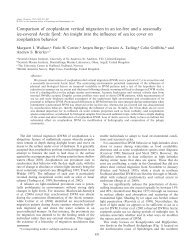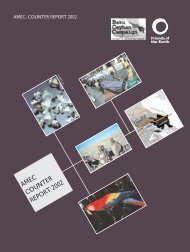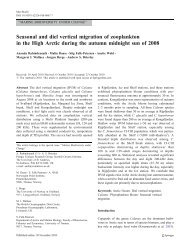Exchange rate dynamics, asset market structure and the role of the ...
Exchange rate dynamics, asset market structure and the role of the ...
Exchange rate dynamics, asset market structure and the role of the ...
Create successful ePaper yourself
Turn your PDF publications into a flip-book with our unique Google optimized e-Paper software.
sume …nancial autarky. They show that models with substantial complementarity between<br />
imported <strong>and</strong> exported goods can yield volatile <strong>and</strong> persistent real exchange <strong>rate</strong>s, address<br />
<strong>the</strong> Backus-Smith puzzle <strong>and</strong> reduce <strong>the</strong> correlation between home <strong>and</strong> foreign consumption<br />
below that <strong>of</strong> home <strong>and</strong> foreign GDP. Interestingly, because <strong>of</strong> <strong>the</strong> assumption <strong>of</strong> consumption<br />
home-bias most <strong>of</strong> <strong>the</strong>se anomalies can be addressed with two values <strong>of</strong> <strong>the</strong> substitution<br />
elasticity. The higher <strong>of</strong> <strong>the</strong> two elasticities corresponds to <strong>the</strong> case where <strong>the</strong> terms <strong>of</strong> trade<br />
depreciate following a positive shock to home total factor productivity. For <strong>the</strong> lower <strong>of</strong> <strong>the</strong><br />
two elasticities, <strong>the</strong> terms <strong>of</strong> trade appreciate following a positive home supply shock. In<br />
this case, <strong>the</strong> terms <strong>of</strong> trade amplify instead <strong>of</strong> dampen <strong>the</strong> e¤ects <strong>of</strong> productivity shocks on<br />
home consumption relative to foreign consumption. The implication is a radically di¤erent<br />
international transmission mechanism for asymmetric supply shocks. Corsetti et al (2006b),<br />
Kollmann (2006) <strong>and</strong> Enders <strong>and</strong> Müller (2008) show that this alternative view <strong>of</strong> <strong>the</strong> transmission<br />
mechanism, what <strong>the</strong>y call negative transmission, is not entirely without empirical<br />
support, for <strong>the</strong> US economy at least.<br />
The purpose <strong>of</strong> this paper is to analyse if <strong>the</strong>se encouraging results also hold in a canonical<br />
‡exible price IRBC model <strong>and</strong> if so, how robust <strong>the</strong>se …ndings really are. What is interesting<br />
is that, depending on <strong>the</strong> calibration, <strong>the</strong> canonical ‡exible price IRBC model performs<br />
surprisingly well, <strong>and</strong> it does so without modelling features designed to address key open<br />
economy macroeconomics facts. The surprising performance <strong>of</strong> <strong>the</strong> baseline model has to<br />
be set against <strong>the</strong> robustness <strong>of</strong> <strong>the</strong> model to changes in key deep parameters. I measure<br />
robustness by <strong>the</strong> size <strong>of</strong> <strong>the</strong> parameter space that allows <strong>the</strong> model to perform in a data<br />
congruent fashion. One is more likely to …nd empirical support for <strong>the</strong> simple IRBC model<br />
if <strong>the</strong> permissible parameter range is large. The smaller <strong>the</strong> range <strong>of</strong> values <strong>of</strong> elasticity <strong>of</strong><br />
substitution between home <strong>and</strong> foreign-produced goods, , that support <strong>the</strong> model, <strong>the</strong> less<br />
likely one is to …nd empirical support for it. The results <strong>of</strong> <strong>the</strong> paper suggest that, for my<br />
parsimonious ‡exible price IRBC model with incomplete …nancial <strong>market</strong>s, <strong>the</strong> range <strong>of</strong> <br />
that supports <strong>the</strong> model is quite narrow indeed. For values outwith this range, for ei<strong>the</strong>r<br />
larger or smaller values <strong>of</strong> , <strong>the</strong> model displays all <strong>the</strong> usual exchange <strong>rate</strong> puzzles. Not<br />
just that, but <strong>the</strong> permissible range <strong>of</strong> is itself a function <strong>of</strong>, among o<strong>the</strong>r factors, <strong>the</strong><br />
degree <strong>of</strong> home-bias in consumption <strong>and</strong> investment expenditure as well as <strong>the</strong> <strong>structure</strong> <strong>of</strong><br />
<strong>the</strong> …nancial <strong>asset</strong> <strong>market</strong>. For example, if <strong>the</strong> degree <strong>of</strong> home-bias in investment is less<br />
than that in consumption, or if home <strong>and</strong> foreign-produced investment goods are better<br />
substitutes for one ano<strong>the</strong>r than are home <strong>and</strong> foreign-produced consumption goods, <strong>the</strong>n<br />
3


